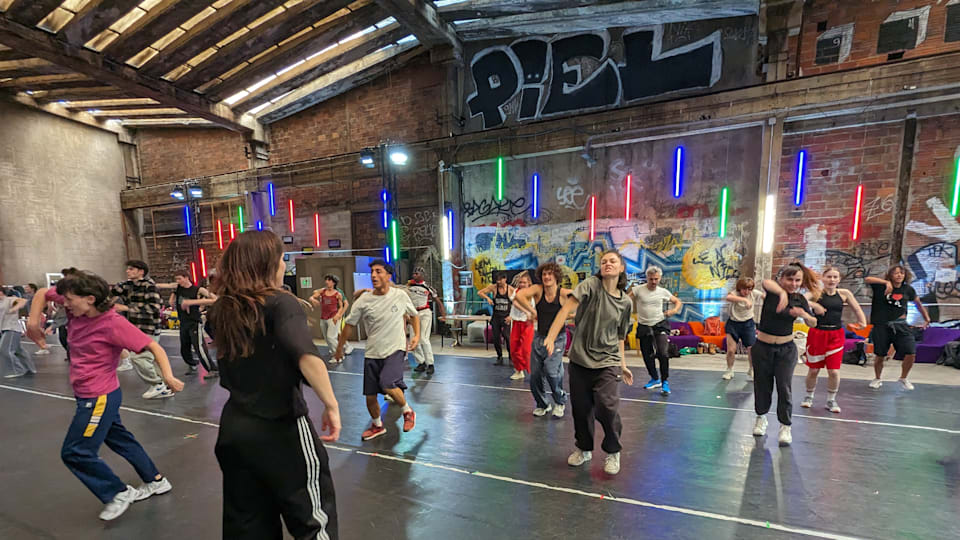One month to Paris 2024: Discover the secrets of the Olympic Games Opening Ceremony on the Seine

An appointment is set in the heart of Seine-Saint-Denis.
On this sunny Friday in early June, a small group of journalists is invited to join the rehearsal for the dancers at the Paris 2024 Opening Ceremony. At the given address, a large carriage door gives no hint of what lies behind it.
After crossing a small courtyard, we discover a hangar, imperceptible from the outside. Inside, graffiti decorates the dark walls, and a large mirror takes up most of the space. It's here, far from curious eyes and in an unusual, confidential location, that the troupe is training to be ready on 26 July.
About fifty young dancers are learning new steps at an intense pace under the guidance of Maud Le Pladec, who has been appointed Director of Dance for the Paris 2024 ceremonies and choreographer of the Opening Ceremony.
The atmosphere is just right, with the artists motivating each other by huddling together and shouting a war cry before starting their demonstration, then applauding each other at the end. They've only known each other since the start of rehearsals on Monday but already seem to be in perfect harmony.
"We train eight hours a day, all week long, and then we'll get together a week before the Olympics to resume training and try it out under real conditions," explains Louise, a 25-year-old dancer.
The group present today is part of a larger ensemble comprising 400 dancers. But they're rehearsing their part on their own, without even knowing what's going on with their peers. "We just know roughly when we're involved and for how long," says Louise.
In all, nearly 3,000 artists will take part in the four opening and closing ceremonies of the Paris 2024 Olympic and Paralympic Games.
A ceremony planned down to the last detail since June 2023
This Friday, we'll get a 30-second glimpse of the Opening Ceremony—a high-energy passage, mixing contemporary and urban styles. For the rest, we'll have to let the dancers get to grips with the steps and wait until 26 July.
"There are rehearsals in hangars like this one, but there are many others," explains Thomas Jolly, artistic director of the ceremonies. "There will also be indoor rehearsals with larger spaces because we can't fit several hundred dancers in here, and we'll go on-site at the last minute."
With just over a month to go before the fateful date, everything is becoming real for the designer of this grand spectacle, who has been working on this project with his colleagues for over a year and a half.
"The ceremony was conceived in June 2023," he explains. "After that, there was a whole feasibility study phase on the resistance of bridges, quays, wind, currents... And since then, we've been adapting, arranging, modifying, until we find the right harmony."
Every detail has been thought through to elevate the City of Light and sport in front of the millions of spectators and TV viewers who will admire the spectacle on 26 July.
"For the opening ceremony of the Olympic Games, we're going to take advantage of all the historic monuments around the Seine, and there won't be a single riverbank or bridge that won't be filled with music, dance, or performance," explains Le Pladec. "We're talking about dance, but there are also more visual tableaux, music, sport, etc.
With the inconsistent weather at the start of 2024 and the instability of the weather in Paris, all types of climatic conditions must be considered for 26 July: driving rain, thunderstorms, strong winds, heat waves... Nothing is left to chance in the design of this ceremony.
"We know we won't be able to control the weather, so we have to take it into account and find a form of flexibility," says Jolly. "We have plans in case the current is a little stronger or a little weaker, and the ceremony will be adapted according to humidity levels. If there are sets that become slippery or dangerous, we'll have to adjust those passages, but others will be preserved."
"The ceremony has a flexible format depending on what we encounter that evening," he continues. "We've anticipated everything, and it's all adaptable. It's called live performance for a reason, you have to work with what's alive, which means the real thing—the river, the sky."
Dawn rehearsals for the boats on the Seine
At the same time, tests are carried out on the Seine very early in the morning to "train" the boats to sail together and follow the meticulous plan of the Opening Ceremony.
"We have to make sure that the boat maintains the right pace—it's a very precise rhythm under each bridge, down to the second," explains boat captain Michel De Vallois. "We're liaising with the ceremony organisers."
"It's coming together. We had a lot of briefings beforehand; it was very theoretical, and many things were explained. Today, we're in the thick of things and starting to envision what the final show could be. It's a technical challenge," he adds.
Tailor-made costumes for the artists
To make it all even more special, Jolly, with the help of host and stylist Daphné Bürki, among others, has created made-to-measure costumes for the performers who will be on the boats for the four Olympic and Paralympic ceremonies.
Unique outfits, one for each of the 3,000 dancers, artists, and athletes who will be putting on the show.
"It's a bit exuberant, it's impressive, it's spectacular, and at the same time, you can feel that there's a kind of story and narrative and a very strong link," says Tony Estanguet, President of Paris 2024.
We look forward to seeing you on 26 July, when all the mysteries surrounding what promises to be a unique and sensational show will be unveiled.
Around 50 dancers rehearse in a hangar in Seine-Saint-Denis just a few days before the Opening Ceremony of the Paris 2024 Olympic Games.